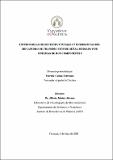Por favor, use este identificador para citar o enlazar a este item:
http://hdl.handle.net/10261/7335COMPARTIR / EXPORTAR:
 SHARE
BASE SHARE
BASE
|
|
| Visualizar otros formatos: MARC | Dublin Core | RDF | ORE | MODS | METS | DIDL | DATACITE | |

| Título: | Estudio de las bases estructurales y enzimáticas del mecanismo de transducción de señal mediado por sistemas de dos componentes |
Autor: | Casino, Patricia CSIC ORCID | Director: | Marina, Alberto CSIC ORCID | Palabras clave: | Biología estructural | Fecha de publicación: | 3-jul-2008 | Editor: | Universidad de Valencia CSIC - Instituto de Biomedicina de Valencia (IBV) |
Resumen: | Los sistemas de dos componentes (TCSs) son los principales sistemas de transducción de señales en procariotas aunque también se encuentran en otros organismos. Sin embargo están ausentes en mamíferos. En general, los TCSs se componen de una histidina quinasa sensora homodimérica (HK) que se autofosforila, mediante ATP, en un residuo de His y un regulador de la respuesta (RR) al cual se transfiere el grupo fosforilo desde la His hasta un residuo de Asp. El RR fosforilado en el residuo de Asp interacciona posteriormente con el ADN u otras dianas provocando respuestas celulares. La señalización se finaliza con la defosforilación del RR mediada por una actividad fosfatasa intrínseca del RR o inducida por la HK.
Existe poco conocimiento estructural de las reacciones de autofosforilación, fosfotransferencia y defosforilación llevadas a cabo por el par HK/RR. De forma que el presente trabajo pretende comprender el mecanismo de transducción de señal en los TCSs utilizando la HK de Clase I HK853 codificada por el gen TM0853 de T. maritima. Para abordar dicho estudio tuvimos que identificar el RR que interaccionaba con HK853 codificado como TM0468. Posteriormente, abordamos la cristalización del complejo formado por la porción citoplasmática de HK853 (HK853-CD) en complejo con RR468 así como la cristalización de RR468 en solitario. Dichas estructuras han proporcionado las bases sobre el mecanismo estructural del reconocimiento molecular y específico entre una HK y su RR, revelando nuevas áreas, en cada proteína, implicadas en la discriminación del estado de fosforilación de cada una. La estructura del complejo también ha proporcionado datos sobre el mecanismo estructural de las reacciones fosfatasa y de fosfotransferencia entre ambas proteínas así como sobre el mecanismo de autofosforilación de la HK. Sorprendentemente, HK853 presenta un mecanismo de autofosforilación de modo cis, indicando que el mecanismo de trans-autofosforilación comúnmente aceptado no es universal para todas las HKs. Todos estos resultados nos han permitido postular un modelo del mecanismo de transducción de la señal en los sistemas de dos componentes. Two component systems (TCSs) are signal transducing devices that, although absent from animals, are present in all domains of life and are the chief transducing systems in prokaryotes. Typically, they are composed of a sensory homodimeric histidine kinase (HK) that is autophosphorylated by ATP at a His residue, and a response regulator (RR) to which the phosphoryl group is relayed on an Asp residue. The Asp-phosphorylated RR then interacts with either DNA or protein targets, triggering cellular responses. Signaling is terminated by RR dephosphorylation by an intrinsic or HK-induced autophosphatase activity of RR. The stimulus governs the response by changing the degree of RR phosphorylation through HK-mediated changes in the autokinase and/or phosphatase activities. There is little structural knowledge on the autophosphorylation, phosphotransfer and dephosphorylation activities of HK/RR pairs so the goal of this work is to understand the mechanism of signal transduction in two component systems using the Class I HK HK853 encoded by the T. maritima gene TM0853. To approach this study we first had to identify the cognate RR of HK853 encoded by TM0468. Afterwards, we approached the first crystal structure of the canonical pair formed by the HK853 cytoplasmic portion (HK853-CD), complexed with RR468 as well as the structure of the uncomplexed RR468. These structures have provided insights into the structural mechanism of molecular recognition and specificity between HKs and RRs, revealing new areas in each protein involved in the discrimination of the partner’s relative phosphorylation state. The complex structure also provides insights into the structural mechanism of the phosphatase and phosphotransfer reactions between both proteins, and also into the mechanism of the histidine kinase autophosphorylation reaction. Surprisingly, HK853 presents a cis mechanism of autophosphorylation, indicating that the commonly accepted mechanism of trans phosphorylation is not universal in all HKs. The results suggest a model for the signal transduction mechanism in two component systems. |
Descripción: | Tesis doctoral del Departamento de Bioquímica y Biología Molecular.-- Fecha de lectura: 22 de septiembre de 2008. | URI: | http://hdl.handle.net/10261/7335 |
| Aparece en las colecciones: | (IBV) Tesis |
Ficheros en este ítem:
| Fichero | Descripción | Tamaño | Formato | |
|---|---|---|---|---|
| TESIS_Patricia_Casino.pdf | 17,31 MB | Adobe PDF |  Visualizar/Abrir |
CORE Recommender
Page view(s)
560
checked on 22-abr-2024
Download(s)
881
checked on 22-abr-2024
Google ScholarTM
Check
NOTA: Los ítems de Digital.CSIC están protegidos por copyright, con todos los derechos reservados, a menos que se indique lo contrario.
